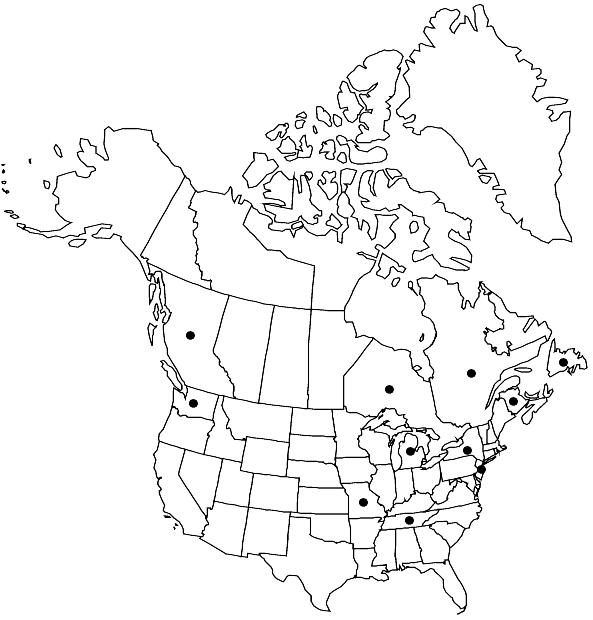Difference between revisions of "Seligeria recurvata"
Bryol. Europ. 2: 12. 1846,.
FNA>Volume Importer |
FNA>Volume Importer |
||
| Line 23: | Line 23: | ||
|habitat=Calcareous substrates | |habitat=Calcareous substrates | ||
|distribution=B.C.;N.B.;Nfld. and Labr. (Nfld.);Ont.;Que.;Mich.;Mo.;N.J.;N.Y.;Tenn.;Wash.;Europe;Asia. | |distribution=B.C.;N.B.;Nfld. and Labr. (Nfld.);Ont.;Que.;Mich.;Mo.;N.J.;N.Y.;Tenn.;Wash.;Europe;Asia. | ||
| − | |discussion=<p>Seligeria recurvata is disjunct in Washington and southern British Columbia to eastern Canada south to Tennessee and west to Michigan. It is distinguished by the combination of cyneous seta, oblong rather narrow capsules, and subulate leaves with the costa filling the apex. Seligeria campylopoda has similar sporophytic features, but has broader leaves with the costa ending in, but not filling, the apex. The spores of both species are small.</p> | + | |discussion=<p><i>Seligeria recurvata</i> is disjunct in Washington and southern British Columbia to eastern Canada south to Tennessee and west to Michigan. It is distinguished by the combination of cyneous seta, oblong rather narrow capsules, and subulate leaves with the costa filling the apex. <i>Seligeria campylopoda</i> has similar sporophytic features, but has broader leaves with the costa ending in, but not filling, the apex. The spores of both species are small.</p> |
|tables= | |tables= | ||
|references= | |references= | ||
| Line 45: | Line 45: | ||
|publication year= | |publication year= | ||
|special status= | |special status= | ||
| − | |source xml=https://jpend@bitbucket.org/aafc-mbb/fna-data-curation.git/src/ | + | |source xml=https://jpend@bitbucket.org/aafc-mbb/fna-data-curation.git/src/8f726806613d60c220dc4493de13607dd3150896/coarse_grained_fna_xml/V27/V27_449.xml |
|genus=Seligeria | |genus=Seligeria | ||
|species=Seligeria recurvata | |species=Seligeria recurvata | ||
Revision as of 16:55, 18 September 2019
Plants tiny or small, olive green. Leaves linear from broad base, slenderly subulate from oblong base, narrowly acute; costa ending in apex, filling subula; margins entire; leaf cells (1–)3:1; perichaetial leaves somewhat larger, similar to vegetative leaves, not much differentiated. Seta 2–3 mm, curved to cygneous. Capsule ovate-oblong to ovate-cylindric, longer than broad, narrower at mouth, peristome of 16 well-developed teeth; columella immersed. Spores 8–10 µm.
Habitat: Calcareous substrates
Distribution

B.C., N.B., Nfld. and Labr. (Nfld.), Ont., Que., Mich., Mo., N.J., N.Y., Tenn., Wash., Europe, Asia.
Discussion
Seligeria recurvata is disjunct in Washington and southern British Columbia to eastern Canada south to Tennessee and west to Michigan. It is distinguished by the combination of cyneous seta, oblong rather narrow capsules, and subulate leaves with the costa filling the apex. Seligeria campylopoda has similar sporophytic features, but has broader leaves with the costa ending in, but not filling, the apex. The spores of both species are small.
Selected References
None.